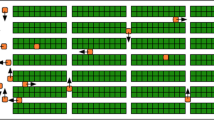Abstract
This study investigates the reverse logistics network design problem, including collection/inspection, recovery and disposal centers that a mixed integer linear programming model is considered. In this network, returned products from customer zones are collected in collection/inspection centers and after quality inspection, and also after separation, recoverable products are shipped to recovery centers and scrapped ones are transported to disposal centers. NP-hardness of this problem is proved in many papers, so a novel meta-heuristic solution method aiming minimization of total costs comprised fixed opening cost of collection/inspection, recovery and disposal centers and transportation cost of products between opened centers using priority based encoding presentation is proposed. Comparison of outputs from this proposed algorithm and a modified genetic algorithm shows the excellence of this new solution method. Finally, some directions for future research are proposed.







Similar content being viewed by others
References
Kannan, G., Sasikumar, P., Devika, K.: A genetic algorithm approach for solving a closed loop supply chain model: a case of battery recycling. Appl. Math. Model. 34, 655–670 (2010)
Min, H., Ko, H.J., Ko, C.S.: A genetic algorithm approach to developing the multi-echelon reverse logistics network for product returns. Omega 34, 56–69 (2006)
Pokharel, S., Mutha, A.: Perspective in reverse logistic: a review. Resourse, Conser. Recycling 53, 175–182 (2009)
Govindan, K., Soleimani, H., Kannan, D.: Reverse logistics and close-loop-supply-chain: a comprehensive review. Eur. J. Oper. Res. 240, 603–626 (2015)
Agrawal, S., Singh, K.R., Murtaza, Q.: A literature review and perspectives in reverse logistics. Resourse, Conser. Recycling 97, 76–92 (2015)
Du, F., Evans, G.: A bi-objective reverse logistics network analysis for post-sale Service. Comput. Oper. Res. 35, 2617–2634 (2008)
Xu, J., Liu, Q., Wang, R.: A class of multi-objective supply chain networks optimal model under random fuzzy environment and its application to the industry of Chinese liquor. Inf. Sci. 178, 2022–2043 (2008)
Wang, H.F., Hsu, H.W.: A closed-loop logistic model with a spanning-tree based genetic algorithm. Computers & operations research. Comput. Oper. Res. 37, 376–389 (2010)
Hoai An, L., Phuc, N., Tao, P.: A continuous DC programming approach to the strategic supply chain design problem from qualified partner set. Eur. J. Oper. Res. 183, 1001–1012 (2007)
Altiparmak, F., Gen, M., Lin, L., Paksoy, T.: A genetic algorithm approach for multi- objective optimization of supply chain networks. Comput. Ind. Eng. 51, 197–216 (2006)
Ko, H.J., Evans, G.W.: A genetic algorithm-based heuristic for the dynamic integrated forward/reverse logistics network for 3PLs. Comput. Oper. Res. 34, 346–366 (2007)
Pishvaee, M., Farahani, R., Dullaert, W.: A memetic algorithm for bi-objective integrated forward/reverse logistics network design. Comput. Oper. Res. 37, 1100–1112 (2010)
Lee, D.H., Dong, M.: Dynamic network design for reverse logistics operations under uncertainty. Transp. Res. E 45, 61–71 (2009)
Yang, T., Wen, Y.F., Wang, F.F.: Evaluation of supply chain information-sharing strategies using a hybrid taguchi and multiple criteria decision making method. Int. J. Prod. Econ. 134(2), 458–466 (2011)
Davis, P.S., Ray, T.L.: A branch-and-bound algorithm for the capacitated facilities location problem. Nav. Res. Logist. 16, 331–44 (1969)
Wu, T.H., Chung, S.H., Chang, C.C.: A water flow-like algorithm for manufacturing cell formation problems. Eur. J. Oper. Res. 205, 346–360 (2010)
Yang, F.C., Wang, Y.P.: Water flow-like algorithm for object grouping problems. J. Chin. Inst. Ind. Eng. 24(6), 475–488 (2007)
Gen, M., Cheng, R.: Genetic algorithms and engineering optimization. Wiley, New York (2000)
Gen, M., Altiparmak, F., Lin, L.: A genetic algorithm for two-stage transportation problem using priority-based encoding. OR Spectr. 28, 337–354 (2006)
Pishvaee, M., Kianfar, K., Karimi, B.: Reverse logistics network design using simulated annealing. Int. J. Adv. Manuf. Technol. (2009). doi:10.1007/s00170-009-2194-5
Author information
Authors and Affiliations
Corresponding author
Rights and permissions
About this article
Cite this article
Zandieh, M., Chensebli, A. Reverse logistics network design: a water flow-like algorithm approach. OPSEARCH 53, 667–692 (2016). https://doi.org/10.1007/s12597-016-0250-0
Accepted:
Published:
Issue Date:
DOI: https://doi.org/10.1007/s12597-016-0250-0




